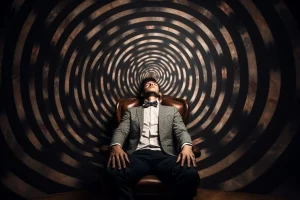Have you ever considered the power of your mind in improving your sleep? Self-hypnosis, a natural and non-invasive technique, can be a game-changer for your sleep quality. It's a fascinating practice that can not only help you fall asleep faster but also enhance the quality of your rest. It's about guiding your mind into a deep state of relaxation, and gently suggesting changes to your subconscious. But how does it work? And more importantly, how can you harness its benefits? In our next discussion, we'll explore this captivating topic further, providing you with a new perspective on achieving better sleep.
Understanding Self-Hypnosis
Often, you might find yourself struggling to sleep, but with the right understanding, self-hypnosis can become a powerful tool in your arsenal to combat insomnia. However, there are myriad hypnosis misconceptions that might be holding you back. You might imagine hypnosis as a mystical process involving pocket watches and spirals, with the hypnotist commanding power over the hypnotized. That's far from the truth.
Historically, hypnotherapy has been a legitimate medical practice for centuries. It's not about control, but rather about teaching you to control your mental state. It's a natural, relaxed state of heightened focus and suggestibility. Hypnosis is a tool that can help you tap into the power of your subconscious mind to bring about change in your behaviors, thoughts, or feelings.
Self-hypnosis, as the name implies, is self-directed and can be used to improve sleep quality. It's about relaxation, focus, and suggestion. You're always in control during self-hypnosis. You can't be made to do anything you don't want to do.
The Science Behind Self-Hypnosis
Delving into the science behind self-hypnosis, you'll find it's not magic, but rather a studied and proven method to tap into the subconscious mind. It's important to debunk some of the hypnosis misconceptions that have been perpetuated by popular culture. You're not surrendering control to another person. Instead, you're putting yourself in a heightened state of focus and suggestibility, also known as a trance state.
During self-hypnosis, you guide yourself into these trance states, using pre-determined suggestions to influence your subconscious. This is where the science comes in. Research shows that during hypnosis, the brain exhibits altered activity in specific areas—the parts responsible for action, awareness, and judgment. Interestingly, the conscious mind takes a step back while the subconscious mind takes the reins.
The trance state is nothing to fear. It's similar to the feeling of being engrossed in a good book or movie and losing track of time. Your mind is focused, receptive, and ready for change.
Benefits of Hypnosis for Sleep
Understanding the science behind self-hypnosis, you're now ready to explore how this tool can potentially enhance your sleep quality and duration. If you're experiencing sleep disorders such as insomnia, night terrors, or sleepwalking, hypnosis could offer a natural, non-pharmacological solution.
Studies suggest that hypnosis can extend the length of your deep sleep phase, ultimately leading to more restful, rejuvenating slumbers. This can translate into improved mood, better cognitive function, and increased overall health. You'll wake up feeling refreshed, not groggy or lethargic.
Now, let's address some common hypnosis misconceptions. You may have heard that hypnosis can make you do things against your will or that it's a form of mind control. This couldn't be further from the truth. In reality, hypnosis is a state of focused relaxation where you're more open to positive suggestions. You're always in control, and it's impossible to be hypnotized into doing something you don't want to do.
Understanding the benefits and debunking the myths, you can see that hypnosis is a safe, effective tool to combat sleep disorders and enhance your nightly rest. It's time to put your worries to bed and welcome a new era of quality sleep.
Preparing for Self-Hypnosis
Before diving into the world of self-hypnosis, there are a few crucial steps you need to take to ensure you're fully prepared for the experience. Creating ambiance and familiarizing yourself with hypnosis equipment are integral parts of this preparation.
Firstly, consider the environment. Creating ambiance is about making a space where you feel relaxed and comfortable, which is essential for successful self-hypnosis. This could be your bedroom, a quiet corner of your home, or even a peaceful spot in your garden. Dim the lights, play soft music, and make the room temperature comfortable. You might also want to consider using aromatherapy candles or essential oils to enhance relaxation.
Next, it's time to get to grips with hypnosis equipment. You don't need much, but a good-quality audio player is crucial. This will play your hypnosis audio tracks, guiding you into a state of deep relaxation. Comfortable headphones can help you focus on the audio and block out distractions.
If you're serious about self-hypnosis, there are also hypnosis machines available that use light and sound to enhance the hypnotic experience.
Step-by-Step Self-Hypnosis Techniques
Now that you're set up, let's walk through some step-by-step techniques to guide you into self-hypnosis. First, find a quiet, comfortable space where you won't be disturbed. Sit or lie down, close your eyes, and take slow, deep breaths. Concentrate on the rhythm of your breathing. This focus will help clear your mind and prepare you for the hypnotic state.
Next, visualize a peaceful place or scenario. This could be anywhere that puts you at ease. You're going to use this image as your safe space during your self-hypnosis session.
Now, engage in progressive muscle relaxation. Start from your toes and work your way up, tensing and relaxing each muscle group. This process further enhances your relaxation.
With hypnosis myths debunked, you know that you're always in control during self-hypnosis. It's not about being 'under', but rather entering a state of heightened focus and relaxation.
Lastly, apply hypnosis safety measures. It's crucial to remember that if something doesn't feel right, you can always stop. You're in control. After you've reached a relaxed state, guide your thoughts towards sleep, allowing the calm and relaxation to lull you into slumber.
Tips for Successful Self-Hypnosis
To ramp up the effectiveness of your self-hypnosis sessions, it's vital to bear in mind a few key tips. Understanding hypnosis safety is paramount. Always choose a quiet, comfortable space where you won't be disturbed. This ensures you can relax fully, thus amplifying the effectiveness of your session.
Additionally, if you're new to self-hypnosis, consider starting with short sessions. As your comfort and familiarity increase, gradually lengthen your sessions.
Don't get caught up in hypnosis myths. Some people fear they'll lose control during self-hypnosis. This isn't true. You're always in control and can stop the session at any time.
Also, don't expect to be completely unconscious or asleep. Hypnosis is a state of focused relaxation where you're more open to suggestions.
Overcoming Common Self-Hypnosis Challenges
While delving into the world of self-hypnosis, you may encounter a few roadblocks that could hinder your progress. It's not unusual to have unusual hypnosis experiences, and these can often make you question the effectiveness of the process. Instead of backing out, consider these challenges as opportunities to learn and grow.
One of the common hurdles is the proliferation of hypnosis myths. You've probably heard that hypnosis can make you lose control or reveal your deepest secrets. But let's get these hypnosis myths debunked. Contrary to popular belief, hypnosis doesn't put you in a trance where you lose control. You're actually in a state of heightened focus and concentration.
Another challenge is the fear of unusual experiences during hypnosis. You may feel certain sensations, like weightlessness or heaviness, which can feel strange. But these are normal parts of the process and are signs that you're entering a state of relaxation.
Exploring Advanced Hypnosis Techniques
Ready to delve deeper into the realm of self-hypnosis? Let's explore some advanced techniques that can further enhance your sleep quality. You've already mastered the basics, so it's time to debunk some hypnosis myths and address hypnosis safety.
Contrary to many hypnosis myths, advanced techniques don't involve swinging pendulums or mind control. They're actually about harnessing the power of your own mind to achieve deep relaxation and sleep. Methods such as visualization, progressive muscle relaxation, and the use of self-suggestions can be more effective when done correctly.
Don't be deterred by the myth that hypnosis is dangerous. Hypnosis safety is paramount, and self-hypnosis is generally considered safe. However, it's essential to approach it with respect. If you're dealing with mental health issues or if you're not seeing improvements, it's advisable to seek professional help.
Conclusion
So, you've discovered the power of self-hypnosis for sleep. It's a natural, effective tool that can help you conquer insomnia and enhance your overall sleep experience.
Remember, the success of self-hypnosis lies in your consistency and patience. Don't get discouraged by initial challenges. With practice, you'll master the techniques and enjoy more restful, rejuvenating slumbers.
Explore advanced techniques as you progress, and unlock the full potential of your subconscious mind.
Sweet dreams!
Dr. John Renoldson is a distinguished professor of Clinical Research Hypnotherapy He holds a PhD in Clinical Psychology and specializes in hypnotherapy and scientific research to enhance therapeutic outcomes. Dr. Renoldson has authored numerous peer-reviewed articles on the efficacy of hypnosis in treating conditions.




